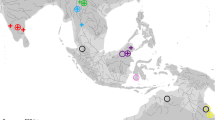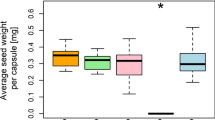Abstract
As a member of the Sanguisorbinae, taxonomically complicated Polylepis Ruiz & Pav. from the South American Andes is one of the few wind-pollinated genera of Rosaceae. Here, it is suggested that problems traditionally faced in species delimitation and phylogeny reconstruction may be in part due to a combination of weak reproductive barriers and the large distances that can be covered by genetic information as a result of wind pollination. The pattern of species distribution as well as molecular data (AFLP) of Polylepis were contrasted with those of an unrelated, insect-pollinated genus of similar species number and distribution, Minthostachys (Griseb.) Spach (Lamiaceae). In the present case, extensive pollen-mediated gene flow may explain the homogenization of genetic variability over larger distances and a lower number of species restricted to individual countries in the wind-pollinated genus Polylepis, but more examples will have to be studied before arriving at final conclusions.
Similar content being viewed by others
References
Adams W. T. and Burczyk J. (2000). Magnitude and implications of gene flow in gene conservation reserves. In: Young, A., Boyle, T. and Boshier, D. (eds) Forest conservation genetics, pp 215–224. CSIRO Publishing, Collingwood, Australia
Beekman M. and Ratnieks F. L. W. (2000). Long-range foraging by the honey-bee, Apis mellifera L. Funct. Ecol. 14: 490–496
Bitter G. (1911). Revision der Gattung Polylepis. Bot. Jahrb. Syst. 45: 564–656
Braun G. (1988) Verbreitung und Ökologie der Gattung Polylepis in den Anden – unter besonderer Berücksichtigung des Vulkan Sajama in der Westkordillere Boliviens. Thesis, Geographisches Institut der Rheinischen Friedrich-Wilhelms-Universität.
Burczyk J., DiFazio S. P. and Adams W. T. (2004). Gene flow in forest trees: How far do genes really travel. For. Genet. 11: 1–14
Dawson J. W. (1960). Natural Acaena hybrids in the vicinity of Wellington. Trans. Roy. Soc. New Zealand. 88: 13–27
Di-Giovanni F., Kevan P. G. and Arnold J. (1996). Lower planetary boundary layer profiles of atmospheric conifer pollen above a seed orchard in northern Ontario, Canada. For. Ecol. Manage. 83: 87–97
Dow B. D. and Ashley M. V. (1998). High levels of gene flow in Bur Oak revealed by paternity analysis using microsatellites. J. Hered. 89: 62–70
Ellenberg H. (1958). Wald oder Steppe? Die natürliche Pflanzendecke der Anden Perus. Umschau 1958: 645–681
Eriksson T., Hibbs M. S., Yoder A. D., Delwiche C. F. and Donoghue M. J. (2003). The phylogeny of Rosoideae (Rosaceae) based on sequences of internal transcribed spacers (ITS) of nuclear ribosomal DNA and the trnL/F region of chloroplast DNA. Int. J. Pl. Sci. 164: 197–211
Excoffier L., Smouse P. E. and Quattro J. M. (1992). Analysis of molecular variance inferred from metric distances among DNA haplotypes: Application to human mitochondrial DNA restriction data. Genetics 131: 479–491
Felsenstein J. (1985). Confidence limits on phylogenies: an approach using the bootstrap. Evolution 39: 783–791
Fjeldså J. and Kessler M. (1996). Conserving the biological diversity of Polylepis woodlands of the highland of Peru and Bolivia: a contribution to sustainable natural resource management in the Andes. NORDECO, Copenhagen, Denmark
Graf K. (1986) Klima und Vegetationsgeographie der Anden – Grundzüge Südamerikas und pollenanalytische Spezialuntersuchungen Boliviens. Zürich.
Hamrick J. L. and Nason J. D. (2000). Gene flow in forest trees. In: Young, A., Boyle, T. and Boshier, D. (eds) Forest conservation genetics: Principles and practice, pp 81–90. CSIRO Publishing, Collingwood, Australia
Jordan E. (1983). Die Verbreitung von Polylepis-Beständen in der Westkordillere Boliviens. Tuexenia 3: 101–112
Kaufman S. R., Smouse P. E. and Alvarez-Buylla E. R. (1998). Pollen-mediated gene flow and differential male reproductive success in a tropical pioneer tree, Cecropia obtusifolia Bertol. (Moraceae): a paternity analysis. Heredity 81: 164–173
Kerr M. S. (2003) A phylogenetic and biogeographic analysis of Sanguisorbeae (Rosaceae) with emphasis on the pleistocene radiation of the high Andean genus Polylepis. PhD thesis, University of Maryland.
Kessler M. (1995a). The genus Polylepis (Rosaceae) in Bolivia. Candollea 50: 131–171
Kessler M. (1995b). Revalidación de Polylepis rugulosa Bitter. Gayana Bot. 52: 49–51
Kessler M. (1995c). Polylepis-Wälder Boliviens: Taxa, Ökologie, Verbreitung und Geschichte. Dissertationes Botanicae 246. J. Cramer, Berlin
Kessler M. (2002). The elevational gradient of Andean plant endemism: varying influences of taxon-specific traits and topography at different taxonomic levels. J. Biogeogr. 29: 1159–1166
Kessler M. and Schmidt-Lebuhn A. N. (2006). Taxonomical and distributional notes on Polylepis (Rosaceae). Org. Div. Evol. 6: 67–69
Lægaard S. (1992). Influence of fire in the grass paramo vegetation of Ecuador. In: Balslev, H. and Luteyn, J. L. (eds) Paramo. An Andean ecosystem under human influence, pp. Academic Press, London
Lindgren D., Paule L., Shen X., Yazdani R., Segerström U., Wallin J.-E. and Lejdebro M.-L. (1995). Can viable pollen carry scots pine genes over long distances. Grana 34: 64–69
Miehe G. and Miehe S. (1994). Zur oberen Waldgrenze in tropischen Gebirgen. Phytocoenologia 24: 53–110
Nei M. and Li W. H. (1979). Mathematical model for studying genetic variation in terms of restriction endonucleases. Proc. Natl. Acad. Sci. USA 76: 5269–5273
Robledo-Arnuncio J. J. and Gil L. (2004). Patterns of pollen dispersal in a small population of Pinus sylvestris L. revealed by total-exclusion paternity analysis. Heredity 94: 13–22
Rogers C. A. and Levetin E. (1998). Evidence of long-distance transport of mountain cedar pollen into Tulsa, Oklahoma. Int. J. Biometry 42: 65–72
Romoleroux K. (1996) Rosaceae. In: Harling G., Andersson L. (eds.) Flora of Ecuador 56, pp. 1–152.
Ruiz L. H., Pavon J. A. (1794) Florae Peruvianae et Chilensis Prodromus. Madrid.
Salgado-Labouriau M. (1979). Modern pollen deposition in the Venezuelan Andes. Grana 18: 53–59
Sargent R. D. (2004). Floral symmetry affects speciation rates in angiosperms. Proc. Roy. Soc. Lond. B 271: 603–608
Schmidt-Lebuhn A. N. (2007) Revision of the genus Minthostachys (Labiate). Mem. New York Bot. Gard. (In Press).
Schmidt-Lebuhn A. N., Kessler M. and Kumar M. (2006). Promiscuity in the Andes: species relationship in Polylepis (Rosaceae, Sanguisorbeae) based on AFLP and morphology. Syst. Bot. 31: 547–559
Schmidt-Lebuhn A. N., Kessler M. and Müller J. (2005). Evolution of Suessenguthia (Acanthaceae) inferred from morphology, AFLP data and ITS rDNA sequences. Org. Div. Evol. 5: 1–13
Schmidt-Lebuhn A. N., Kumar, M., Kessler, M. (2007) An assessment of the genetic population structure of two species of Polylepis (Rosaceae) in the Chilean Andes. Flora. (In press).
Schneider S., Roessli D., Excoffier L. (2000) Arlequin ver. 2.000: A software for population genetics data analysis. Genetics and Biometry Laboratory, University of Geneva, Switzerland.
Schuster W. S. F. and Mitton J. B. (2000). Paternity and gene dispersal in limber pine (Pinus flexilis James). Heredity 84: 348–361
Simpson B. B. (1979) A revision of the genus Polylepis (Rosaceae: Sanguisorbeae). Smiths. Contr. Bot. 43. 62 pp.
Simpson B. B. (1986). Speciation and specialization of Polylepis in the Andes. In: Vuilleumier, F. and Monasterio, M. (eds) High altitude tropical biogeography, pp 304–316. Oxford University Press, Oxford
Smouse P. E. and Sork V. L. (2004). Measuring pollen flow in forest trees: an exposition of alternative approaches. For. Ecol. Manage. 197: 21–38
Sork V. L., Davis F. W., Smouse P. E., Apsit V. J., Dyer R. J., Fernandez-M. J. F. and Kuhn B. (2002). Pollen movement in declining populations of California Valley oak, Quercus lobata: where have all the fathers gone. Molec. Ecol. 11: 1657–1668
Swofford D. L. (2002). PAUP*, Phylogenetic Analysis using Parsimony (*and Other Methods) version 4.0b10. Sinauer Associates, Sunderland, Masachusetts
SYSTAT (1997) SYSTAT for Windows, statistics, version 7.0. SPSS Inc., Chicago.
Thomson J. D., Wilson P., Valenzuela M. and Malzone M. (2000). Pollen presentation and pollination syndromes, with special reference to Penstemon. Pl. Sp. Biol. 15: 11–29
Van de Peer Y. and de Wachter R. (1994). TREECON for Windows: a software package for the construction and drawing of evolutionary trees for the Microsoft Windows environment. Comp. Appl. Biosci. 10: 569–570
Waller G. D. (1980). Managing colonies for crop pollination. In: Maretin, E. C. (eds) Beekeeping in the United States, pp 73–77. US Department of Agriculture, Washington
Whittle C. A. and Johnston M. O. (2003). Broad-scale analysis contradicts the theory that generation time affects molecular evolution rates in plants. J. Molec. Evol. 56: 223–233
Author information
Authors and Affiliations
Corresponding author
Rights and permissions
About this article
Cite this article
Schmidt-Lebuhn, A., Seltmann, P. & Kessler, M. Consequences of the pollination system on genetic structure and patterns of species distribution in the Andean genus Polylepis (Rosaceae): a comparative study. Plant Syst. Evol. 266, 91–103 (2007). https://doi.org/10.1007/s00606-007-0543-0
Received:
Accepted:
Published:
Issue Date:
DOI: https://doi.org/10.1007/s00606-007-0543-0




